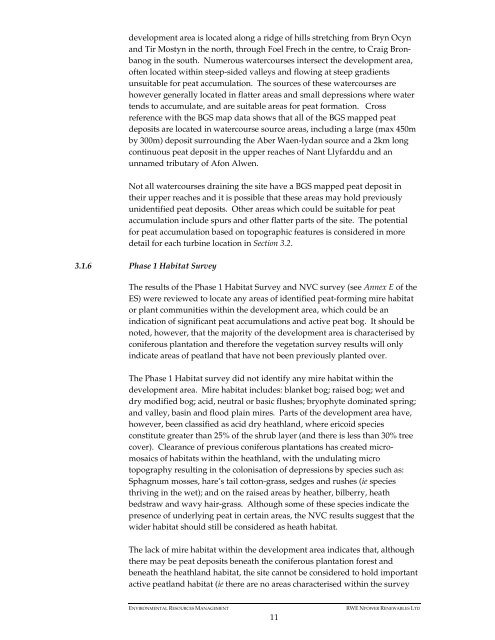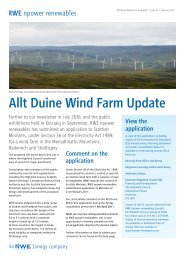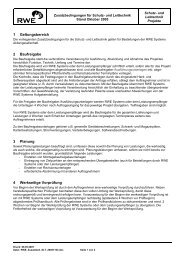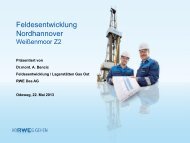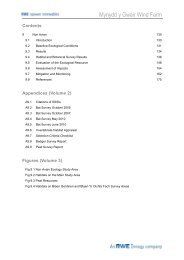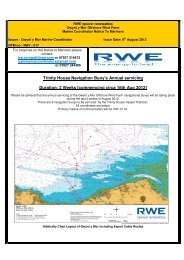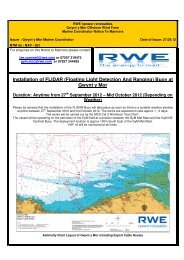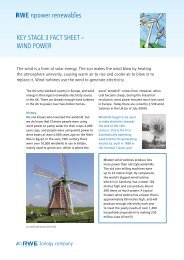F. Geology & Hydrology ( PDF | 31.0 MB ) - RWE.com
F. Geology & Hydrology ( PDF | 31.0 MB ) - RWE.com
F. Geology & Hydrology ( PDF | 31.0 MB ) - RWE.com
Create successful ePaper yourself
Turn your PDF publications into a flip-book with our unique Google optimized e-Paper software.
development area is located along a ridge of hills stretching from Bryn Ocyn<br />
and Tir Mostyn in the north, through Foel Frech in the centre, to Craig Bronbanog<br />
in the south. Numerous watercourses intersect the development area,<br />
often located within steep-sided valleys and flowing at steep gradients<br />
unsuitable for peat accumulation. The sources of these watercourses are<br />
however generally located in flatter areas and small depressions where water<br />
tends to accumulate, and are suitable areas for peat formation. Cross<br />
reference with the BGS map data shows that all of the BGS mapped peat<br />
deposits are located in watercourse source areas, including a large (max 450m<br />
by 300m) deposit surrounding the Aber Waen-lydan source and a 2km long<br />
continuous peat deposit in the upper reaches of Nant Llyfarddu and an<br />
unnamed tributary of Afon Alwen.<br />
Not all watercourses draining the site have a BGS mapped peat deposit in<br />
their upper reaches and it is possible that these areas may hold previously<br />
unidentified peat deposits. Other areas which could be suitable for peat<br />
accumulation include spurs and other flatter parts of the site. The potential<br />
for peat accumulation based on topographic features is considered in more<br />
detail for each turbine location in Section 3.2.<br />
3.1.6 Phase 1 Habitat Survey<br />
The results of the Phase 1 Habitat Survey and NVC survey (see Annex E of the<br />
ES) were reviewed to locate any areas of identified peat-forming mire habitat<br />
or plant <strong>com</strong>munities within the development area, which could be an<br />
indication of significant peat accumulations and active peat bog. It should be<br />
noted, however, that the majority of the development area is characterised by<br />
coniferous plantation and therefore the vegetation survey results will only<br />
indicate areas of peatland that have not been previously planted over.<br />
The Phase 1 Habitat survey did not identify any mire habitat within the<br />
development area. Mire habitat includes: blanket bog; raised bog; wet and<br />
dry modified bog; acid, neutral or basic flushes; bryophyte dominated spring;<br />
and valley, basin and flood plain mires. Parts of the development area have,<br />
however, been classified as acid dry heathland, where ericoid species<br />
constitute greater than 25% of the shrub layer (and there is less than 30% tree<br />
cover). Clearance of previous coniferous plantations has created micromosaics<br />
of habitats within the heathland, with the undulating micro<br />
topography resulting in the colonisation of depressions by species such as:<br />
Sphagnum mosses, hare’s tail cotton-grass, sedges and rushes (ie species<br />
thriving in the wet); and on the raised areas by heather, bilberry, heath<br />
bedstraw and wavy hair-grass. Although some of these species indicate the<br />
presence of underlying peat in certain areas, the NVC results suggest that the<br />
wider habitat should still be considered as heath habitat.<br />
The lack of mire habitat within the development area indicates that, although<br />
there may be peat deposits beneath the coniferous plantation forest and<br />
beneath the heathland habitat, the site cannot be considered to hold important<br />
active peatland habitat (ie there are no areas characterised within the survey<br />
ENVIRONMENTAL RESOURCES MANAGEMENT <strong>RWE</strong> NPOWER RENEWABLES LTD<br />
11


